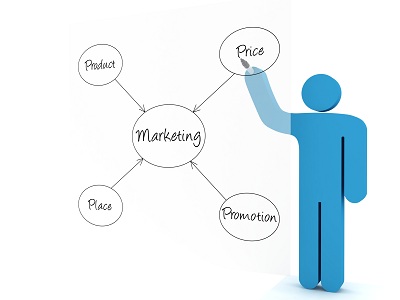
MKTG422:
Lesson 01: Introduction to Integrated Marketing Communications
Introduction

(Image © (2011) Jupiterimages Corporation)
The objective of this lesson is to introduce you to the field of advertising and promotion and explain its role in the overall marketing process. I am sure you have heard the term integrated marketing communications (IMC) before in the previous marketing courses you have completed, but it might have just sounded like a buzzword then. This lesson introduces the concept in more depth and emphasizes the increasing importance of coordination and execution of the various communication functions as a part of the overall marketing strategy planning. Significant changes in the changing marketing environment, especially with respect to the consumer behavior, technology, and media necessitate the coordination of all customer contacts by the firm.
Furthermore, IMC should not be viewed in isolation but rather interpreted as an integral part of market orientation and strategy planning. As we learned, coordination across departments to create customer value is a key factor for the success of market orientation. Similarly, IMC expects the synchronization and harmonization of the company voice to develop and support a consistent brand image and position. Therefore, in this lesson, we will also reexamine the marketing process and refresh your knowledge about the concepts of marketing mix, target marketing, segmentation, and positioning while keeping in mind that the goal of marketing is to develop and sustain relationships with customers and deliver value to them. In this process, identification of unfulfilled needs and communication of the benefits offered by the firm’s offering are some of the crucial activities that need to be performed by marketers. We will also summarize the key ideas and decision areas that shape marketing strategy planning.
Lesson 01 Objectives
After completing this lesson you should be able to do the following:
- Define integrated marketing communications and explain its growing importance.
- List and explain the various elements of the promotional mix.
- Identify various types of customer contact points through which marketers communicate with their target audiences.
- Explain the marketing process and different elements of the marketing mix.
- Explain the concept of target marketing in an integrated marketing communications program.
- Discuss the role of market segmentation and its use in an integrated marketing communications program.
- Explain marketing positioning and repositioning strategy.
- Explain how promotional strategy is influenced by and interacts with marketing strategy.
Lesson 01 Road Map
| Lesson 01: Introduction to Integrated Marketing Communications | |
|---|---|
|
Readings: |
|
|
Assignments: |
|
What Is Marketing?
By this time, many of you have already had a marketing course and feel quite comfortable about providing a good definition of marketing. However, there is no harm with a little redundancy and to refresh our memories.
Earlier definitions of marketing usually focused on the “exchange” between buyers and sellers. More recently, we have started using a definition more reflective of the current marketing thought process. Accordingly, marketing may be defined as the activities that are designed to accomplish an organization’s goals by understanding customer needs, creating value to satisfy those needs, and building long-term relationships with customers. You'll notice that this definition focuses more on delivering value to customers and sustaining relationships with them.
So, what is value? It is related to the customer’s perception of the difference between the benefits of a product and the costs of having the product.

Graphic created in Microsoft Office (© 2012)
Figure 1.1. Value Equation
Therefore, we have to look from the customer’s point of view in defining the value. Products can deliver a variety of benefits (functional, experiential, and psychological) to the customers. Therefore, to increase the value of a product in consumer’s mind, marketers need to convince customers about those benefits and reduce the costs of acquiring them.
What Is IMC?
Perhaps the best way to explain IMC is to see it as an integral part of the market orientation. Accordingly, IMC is “a strategic business process used to plan, develop, execute and evaluate coordinated, measurable, brand communications programs over time with consumers, customers, prospects, employees, associates and other targeted relevant external and internal audiences (p. n/a).” (Source: Shultz, D. and Shultz, H. (2004). IMC: The next generation: 5 steps for delivering value and measuring returns using marketing communication. New York: The McGraw-Hill Company.)
As you may notice , this definition assumes that integrated marketing communication is an ongoing process rather than a short-term tactical decision.
It is important to note that the elements of the promotional mix (also referred to as the "marketing mix") contained in the IMC go beyond the traditional communication tools of advertising, sales promotion, publicity/public relations and personal selling. Direct marketing and interactive/Internet marketing should be part of the mix. As we know, the rapid growth of the Internet and social media which is changing the nature of how companies do business and the ways they communicate with consumers.
The Marketing Mix and Its Interaction with IMC
In order to accomplish organizational goals, the various elements of the marketing mix need to be organized into a cohesive and effective marketing program.

(Image © (2012) Jupiterimages Corporation)
We have learned that marketing mix consists of four elements, namely
- product,
- place,
- promotion, and
- price.
These elements need to be consistent with one another, and each of these elements includes a number of decisions, but you have to pay specific attention with respect to how each interacts with promotion. So, it's the job of marketing management to blend these four elements together in a way to elicit customer response. For example, a new product with a very low promotion budget probably won't succeed and most consumers will reject a "no-frills" product with a high price. Most marketing decisions depend on the careful integration of the marketing mix.
In practice you may also hear the term supply chain management used instead of "place" and Integrated Marketing Communication (IMC) used instead of "promotion." In other words, the promotional program must be effectively coordinated with other marketing mix variables.
Evidence shows that advertising and promotion have an increasing role in the marketing process and many companies have begun to adopt the concept of an IMC, which involves coordinating the various promotional elements along with other marketing activities to communicate with a firm’s customers. IMC means focusing on the “big picture” when planning marketing and promotion programs and coordinating various communication functions.
All marketing and communication activities surrounding a product should project a consistent and unified image to the market.
Elements of the Promotional Mix
As we know, promotion is best viewed as seller initiated business communications to provide information and persuade customers to buy company offerings.
There are a number of tools available—advertising, public relations/publicity, personal selling, sales promotion, direct marketing, and interactive marketing—for marketers to promote their offerings. These are briefly explained in the following video.
Customer Contact Points
There are a variety of ways by which customers come into contact with a company and/or its brands. In order to be able to develop integrated and coordinated marketing communications, marketers have to pay attention and use all tools available for them to get in contact with their customers. Each and every time a customer gets in contact with the company’s offerings, marketers have the ability to communicate the consistent and favorable message about their products. All potential ways of reaching customers should be part of the IMC programs and marketers need to determine how each of these contact tools should be used to communicate with the target customers.
The presentation below discusses the various tools with which customers are contacted.
customerContactTools_CAP.xmlPromotions and Marketing Strategy
As mentioned earlier, the focus in this course is the promotional variable of the marketing mix. However, the promotional mix must be an integral part of the overall marketing strategy. A company can spend significant amounts of money on advertising and promotion but if the product quality, price, and distribution decisions are not performed properly, then the strategy is destined to failure.
Therefore, we have to pay a close attention to how marketing strategies influence the role of promotion and how promotional decisions could be coordinated with the other areas of the marketing mix. We can illustrate this process as follows:
Marketing Strategy Process
Identifying product and market: First, the company determines the product or service areas and particular markets in which it plans to compete. This requires a detailed understanding of the market, the opportunities, and the competition.
Analyze marketplace conditions: Sometimes there are favorable trends (opportunities) for different products. For instance, in the technology space, smart phones and mobile communication present favorable market opportunities. However, a company must analyze and consider the competitive conditions in the marketplace.
Evaluate market opportunities: You might recall that HP has recently pulled out of the tablet market due to intense competition. The company's marketers evaluated the market and saw the opportunities were limited. What is really important is to focus on and search for an advantage (competitive advantage) over the competition. The competitive advantage may be achieved in different ways such as through a differentiated product, superior customer service, and low-cost production or efficient distribution systems. Competitive advantage might be also achieved through excellent advertising and promotion programs.
Select target market: After evaluating the opportunities for products/services, target market(s) are selected. The selection of the target market is not only a very important part of a firm’s marketing strategy, but also has important implications for advertising and promotional strategy and tactics.
Target Marketing Process

(Image © (2012) Jupiterimages Corporation)
Target marketing involves the identification of the needs and wants of specific groups of customers and tailoring the marketing mix according to their needs. This process leads to a more homogeneous grouping of potential customers, which allows the marketer to develop more precise strategies designed to reach them.
Once the marketers have identified who they want to target, these potential customers are grouped based on their similarities in terms of needs and/or behaviors that are likely to cause them to respond similarly to marketing actions. This breaking up of the market is referred to as the market segmentation process.
After developing the segments, the marketers face a few decision points regarding the target market:
- Ignore the segment differences and develop one marketing mix for the entire market (undifferentiated marketing).
- Design different marketing mixes for several different segments (differentiated marketing).
- Simply concentrate efforts on one specific segment in an attempt to capture a large share of that market (concentrated marketing).
Finally, the marketer decides on the positioning strategy. Positioning refers to arranging your product in a way to occupy a clear and distinctive place in customers’ minds in comparison to competing products (i.e., BMW means luxury car and will not be confused with a Ford). Positioning may be done by product attributes, price, quality, user and/or cultural symbols, etc.
Developing the Marketing Mix
Next, the elements of the marketing mix must be combined effectively and be consistent with one another. The elements of the marketing mix influence one another and they interact with promotional variables significantly.
Product Decisions—any offerings of the firm that satisfy customer needs. Product decisions include branding and packaging, which are particularly important from a promotional perspective because of the role the brand name and package play in communicating attributes, information, and meaning to the consumer. An important role of advertising is creating and maintaining brand equity—an intangible asset of added value or goodwill that results from the favorable image, impressions of differentiation, and/or the strength of consumer attachment to a brand name.
Price Decisions—what the consumer must give up in exchange for a product or service. Setting a price level, developing pricing policies, and monitoring consumers’ and competitors’ reactions to price in the marketplace are part of these decisions. Usually a number of factors, such as costs, demand, image, and competition, etc. influence pricing decisions.
Distribution Channel Decisions (Place)—the set of interdependent organizations involved in the process of making a product or service available to customers. Marketers need to decide if they will distribute their products directly or used middlemen. The use of middlemen is important decision in marketing and promotional strategy. The Internet has become a new channel for a number of companies, and has had a demonstrable impact on the distribution system. The success of Amazon.com is an example.
Developing Promotional Strategies: Push or Pull? – Marketers can use a push promotional strategy to persuade the resellers to sell a company’s products. The sales representatives are important in this process as they can call resellers and offer special programs such as promotional allowances and cooperative advertising. Trade advertising in publications that serve the industry may also be used as part of a push strategy. When a promotional pull strategy is used, the goal is to create demand among end users which will in turn encourage retailers to carry a brand. Heavy spending on consumer advertising and sales promotion is an important part of a pull strategy.
Concluding Remarks
In this lesson, we have described IMC and focused on the necessity for integrating all marketing communications to present a consistent message and a favorable view of the brand. We also provided an overview of the overall marketing process and the role advertising and promotion play in the marketing program.
We used marketing and promotion process frameworks for analyzing how promotion fits into an organization’s marketing program. The model shows that promotional programs must be developed for middlemen as well as for the ultimate customer in the target market. It is important to note that resellers play a crucial role and marketers need to develop promotional programs to motivate the trade to get them to stock merchandise and promote a company’s products. Marketers might also decide to shift the allocation of promotional budgets toward trade promotions.
Lesson 01 Activities
Complete all of the following tasks by the due dates listed in the Course Syllabus:
Lesson Readings
Complete the readings listed in the Course Syllabus.Discussion Forums
Discuss the following two questions on their respective discussion forums. Please review the Discussion Forum Guidelines. Your initial discussion post for each question is due by Friday. Your responses to your classmates' initial posts are due by Sunday.
Discussion Forum #1 - Commercials: (3 points)
Volkswagen and Chevy Camaro ads are considered the best commercials. Watch the Volkswagen Dart Vader commercial at http://www.youtube.com/watch?v=R55e-uHQna0 and the Chevy Camaro commercial at http://www.youtube.com/watch?v=wFVxNTVC5Yk.
For each commercial, answer the following questions:
- Who do you think is the specific target market for each of these products?
- Do you think the commercial is effective in helping the brand image?
- Which positioning strategy is being employed by each product?
Please post your response to the discussion forum, Lesson 01: Commercials.
Discussion Forum #2 - Consumer Empowerment: (3 points)
Having read the JMC article assigned in this lesson, briefly discuss the five enablers of consumer empowerment in the process of marketing communication. What kind of challenges and opportunities do they present to marketers? Please post your response to the discussion forum, Lesson 01: Consumer Empowerment.
Self-Assessment Quizzes
Complete the self-assessment quizzes for Chapters 1 and Chapter 2 from the textbook website.- Select Chapter from the dropdown list.
- Select Chapter Quiz.
- Click the Submit Answers button to see the results. These are NOT GRADED, but they are expected to help you to assess your understanding of the information covered in the chapter. You do NOT need to send the results to your instructor unless you have any questions about the sample quiz questions.